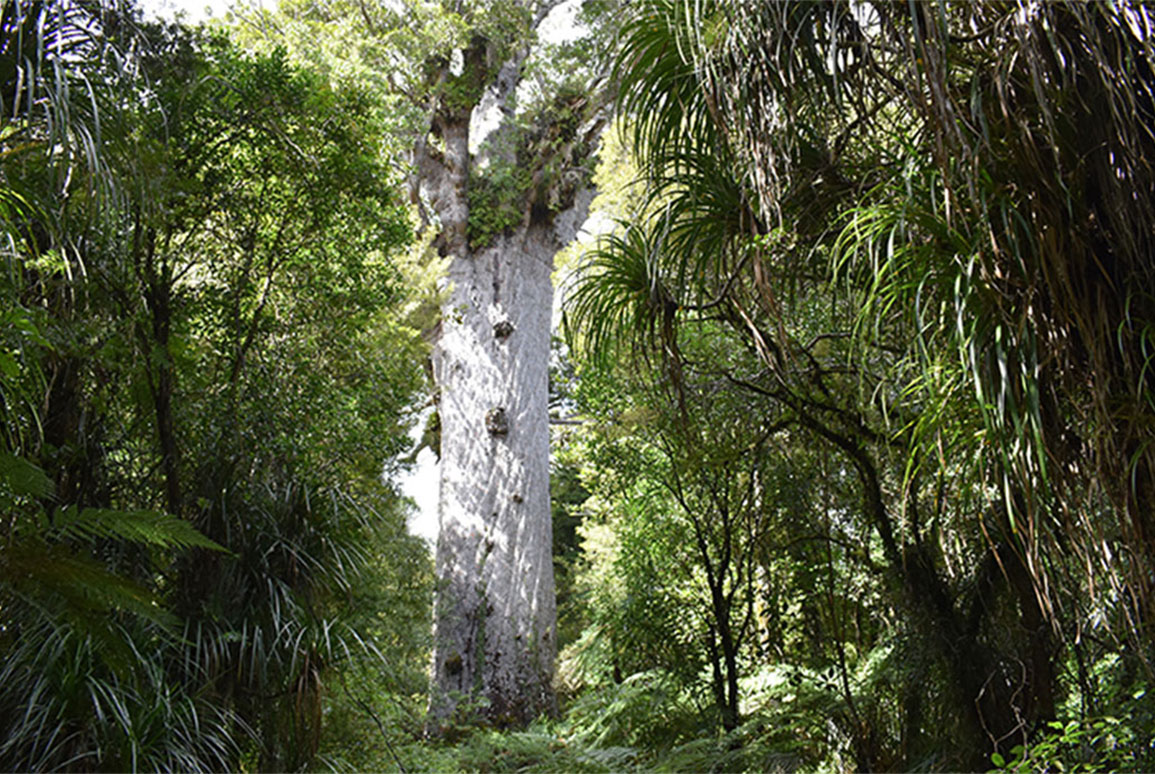The fight to keep our Kauri standing
17 December 2020
It was first found in the Waitākere Ranges nearly 15 years ago, but over the past five years the rapid rate of "kauri dieback" spread has become an urgent concern. Biosecurity consultant Kate Heaphy explains the most recent developments in the fight to save Aotearoa's iconic trees.

Kauri forests (Agathis australis) used to cover 1.2 million ha of the upper North Island. These ancient ecosystem engineers, the largest tree in New Zealand by volume, can live for over 2000 years.
However, our kauri are dying. The cause was originally misidentified as the pathogen Phytophthora heveae, and then was temporarily classified as the water mould Phytophthora taxon Agathis (PTA). In 2015, it was finally officially described as Phytophthora agathidicida, literally meaning kauri-killer. More commonly known as kauri dieback, there is still no known cure.
So how do we manage such a disease?
Clean everything. Boots, equipment and vehicles.
Then, we need to find out where it is – in many areas, the presence and distribution of kauri dieback is still unknown.
We all know the importance of testing and presence/absence data from our experiences with COVID-19. As luck and hard work would have it, a new method of detecting P. agathidicida (a loop-mediated isothermal amplification assay or “LAMP” test) was published by Richard Winkworth and colleagues earlier in 2020*. This highly specific and highly sensitive test has been a leap forward in informing and improving our management practices.
Multiple large infrastructure projects currently underway within the greater Auckland region are crucial to ensure the needs of Auckland’s growing population are supported. Many of these are occurring in areas where kauri is present or nearby, with potential to spread kauri dieback. Effective, informed management of kauri dieback during these projects is equally crucial to protect our valuable and iconic ecosystems.
Boffa Miskell has a key role in many of these infrastructure projects, and our ecology team specialises in developing Ecological Management Plans (EMPs) which include stringent kauri dieback management protocols where kauri may be affected. Management plans typically include protocols that adopt a precautionary approach (assumed presence) for:
- Rigorous testing for the pathogen as part of pre-construction planning and risk assessment;
- Strict sediment control and overland flow management;
- Construction protocols, including for the removal and disposal of soil if required; and
- Stringent cleaning protocols, both around the project footprint and within Kauri Containment Zones (a standard distance of three times the canopy drip line of any kauri specimens).
This year, we have been working closely with the expert team at Biosense who have been using the LAMP method with great success to determine kauri dieback presence and distribution at one of our major project sites.
This testing provides us with valuable information, such as:
- Increasing our knowledge of the local distribution of kauri dieback pathogens, to inform soil containment and overland flow management within project sites;
- Providing baseline presence/absence data of kauri dieback, to determine in future whether the mitigation measures have been successful at preventing the spread (if detected, this will provide reassurance for all that kauri dieback was not introduced solely as a consequence of the project and also help similar projects adapt their mitigation measures in future);
- Informing the decision as to whether to include kauri in revegetation plans (if not detected, there may be opportunities to restore a historically dominant, severely reduced ecosystem type. However, if detected, there is little benefit to planting kauri trees that are almost guaranteed to become infected and eventually die, and potentially creating a further host population for the disease);
- Contributing to leading research and science and help answer remaining questions such as other host species, accuracy of field observations in determining infection and potentially ongoing monitoring for treatment monitoring; and
- Identifying ‘confirmed cases’, after which sick trees can be treated with phosphite injections (although not a cure, phosphite injections give sick tree’s immune systems a ‘boost’ with successful results to date around the Auckland region).
Testing at one of our project sites this year revealed that the distribution of kauri dieback can be extremely extensive within a project site and even within a catchment. Stream-baiting (a method of efficiently collecting water samples for the LAMP test) has detected kauri dieback within flowing streams, meaning that the disease is being naturally widely spread via water. The results also show that the disease may be present in soil some distance from kauri trees.
Although disappointing, these results brings a strong realisation. Beyond managing individual trees and their root zones, we need a holistic, catchment wide approach that acknowledges that kauri dieback management involves the water, the soil and multiple potential host species.
Kauri dieback is an active field of research with multiple facets and research directions. Some of the most talented scientists, passionate community members, arborists and industry are working together to learn about this disease and how to control it. This leap forward in detection methods provides another ray of hope.
* Winkworth, R. C., Nelson, B. C., Bellgard, S. E., Probst, C. M., McLenachan, P. A., & Lockhart, P. J. (2020). A LAMP at the end of the tunnel: A rapid, field deployable assay for the kauri dieback pathogen, Phytophthora agathidicida. PloS one, 15(1), e0224007.
For further information please contact Dr. Sarah Flynn

